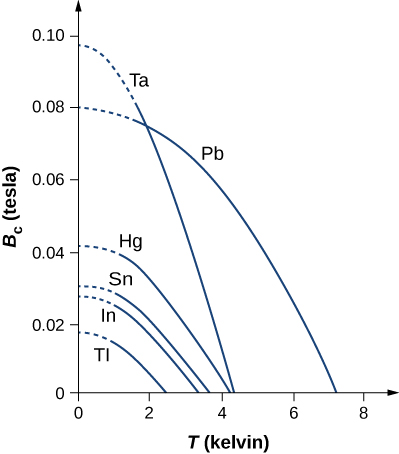| << Chapter < Page | Chapter >> Page > |
High-temperature superconducting materials are presently in use in various applications. An example is the production of magnetic fields in some particle accelerators. The ultimate goal is to discover materials that are superconducting at room temperature. Without any cooling requirements, the bulk of electronic components and transmission lines could be superconducting, resulting in dramatic and unprecedented increases in efficiency and performance.
Another important property of a superconducting material is its critical magnetic field which is the maximum applied magnetic field at a temperature T that will allow a material to remain superconducting. An applied field that is greater than the critical field will destroy the superconductivity. The critical field is zero at the critical temperature and increases as the temperature decreases. Plots of the critical field versus temperature for several superconducting materials are shown in [link] . The temperature dependence of the critical field can be described approximately by
where is the critical field at absolute zero temperature. [link] lists the critical temperatures and fields for two classes of superconductors: type I superconductor and type II superconductor . In general, type I superconductors are elements, such as aluminum and mercury. They are perfectly diamagnetic below a critical field B C ( T ), and enter the normal non-superconducting state once that field is exceeded. The critical fields of type I superconductors are generally quite low (well below one tesla). For this reason, they cannot be used in applications requiring the production of high magnetic fields, which would destroy their superconducting state.

| Material | Critical Temperature | Critical Magnetic Field |
|---|---|---|
| Type I | ||
| Type II | ||
Type II superconductors are generally compounds or alloys involving transition metals or actinide series elements. Almost all superconductors with relatively high critical temperatures are type II. They have two critical fields, represented by and . When the field is below type II superconductors are perfectly diamagnetic, and no magnetic flux penetration into the material can occur. For a field exceeding they are driven into their normal state. When the field is greater than but less than type II superconductors are said to be in a mixed state. Although there is some magnetic flux penetration in the mixed state, the resistance of the material is zero. Within the superconductor, filament-like regions exist that have normal electrical and magnetic properties interspersed between regions that are superconducting with perfect diamagnetism. A representation of this state is given in [link] . The magnetic field is expelled from the superconducting regions but exists in the normal regions. In general, is very large compared with the critical fields of type I superconductors, so wire made of type II superconducting material is suitable for the windings of high-field magnets.

Notification Switch
Would you like to follow the 'University physics volume 3' conversation and receive update notifications?